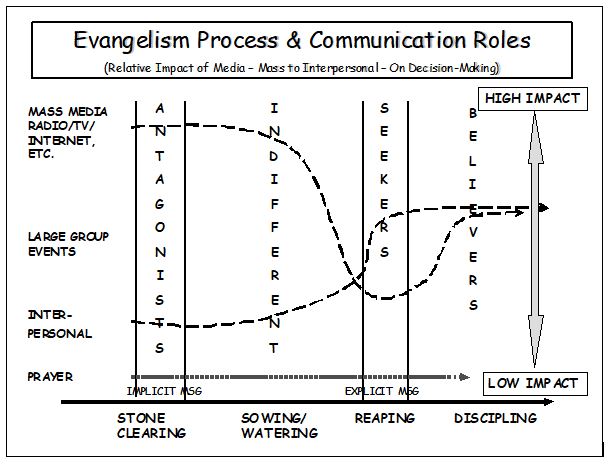The Good News is a highly personal Gospel. This brief article suggests, whether for evangelism or discipleship, there is value in considering the nature and potentials of the communications media we use. I only seek to encourage you and your colleagues’ thoughtful consideration.
Digitally-based communications have brought options previously only dreamed of. With social media (SM), communicators seeking to connect with and interact with individuals, a whole new world of options emerge. Consider the potential of what communications in cyberspace brings. Here are just a few of the more obvious implications:
- Geographic specificity – down to postal code levels or even more specific targeting.
- Ability to cluster individuals around topics/issues of common interest.
- Ability to empower audience groupings interaction with each other.
- Real time feedback – a new environment empowering two-way individual and group communications.
- “Audience” participation in innovation and ideation.
At the outset, let’s consider some of those very personal aspects of the Gospel we proclaim.
Consider the incarnation.
“The Word became flesh and dwelt among us”
John 1:14
While there has been extraordinary diversity in God’s communication, it was ultimately reflected – in a person, Jesus Christ.
Hebrews 1:1-14
The Gospel is not just words but is linked consistently with specific works meeting real people’s needs in real circumstances. Consider —
John 10:38
James 2:14-26, etc.
These days we might ask, Why didn’t God send a ‘virtual’ Jesus? But, no, “the word became flesh and dwelt among us.” We heard, touched, and saw….
I John 1:1-3
Then, there are the authors who have documented the role of individuals living in community which provided a powerful, desirable alternative to indifference of general society. The lives of these people became the engine for the great growth of the church in the first 300 years. The idea of the “witness” of early believers in a highly relational, community-based society is likely hard to imagine considering our experience in highly individualistic, Western societies. Here are a few of those who have documented the power of real people demonstrating the Good News to those around them.
Rodney Stark
The Cities of God
Robert Banks
Paul’s Idea of Community
Michael Green
Evangelism & The Early Church
The power of electronic/digital media is inverse to the social implications of the decision being considered — whether it is a one time or “lifestyle” decision. This, of course is particularly true in more traditional, community-based cultures.
Consider God, capable of creating or communicating at any way He likes. Why didn’t He give Adam and Eve ‘virtual’ headsets vs. “walking and talking in the cool of the evening”? The God of the cosmos taking the time, walking and talking with two individuals?
Consider God, living in community/relationships outside of time. (Examples in Genesis, Job, Daniel, Ephesians, etc.) And so we hear, “Let Us make man in Our image.” His was a highly personal creation.
We know that hands on skin can be repulsive, reassuring, sensual, or electrifying – communicate anger, compassion, love, care, or brutality.
What are the implications of Jesus’ “laying on of hands” in Luke 4:40? And as everyone else shrank back in fear or revulsion, Jesus’ hands reached out as no one else would – to the lepers as in Matthew 8:2-3.
The ever-evolving new media present us with both new opportunity and new challenges. As we think of real, individual people, to what extent will our communications be a message of inclusion or exclusion?
All forms of communication have ‘unique’ capacity or power; from stone tablets and cave drawings to papyri, parchment, Gutenberg’s press, Marconi’s telegraph, Bell’s telephone, and, now, the digital world of the internet, social media, etc. Yet, the power or influence of any medium we consider has limits. So, if we’re engaged in an evangelism or discipleship ministry using anything other than face to face communications, how do we “personalize” the message?
The chart below suggests why framing the Good News in a personal way is so important. Research suggests that, in broad terms, more traditional “mass media” of various types is best at raising awareness and presenting options. Typically, this means the “sowing and watering” part of the evangelism process (see John 4:35-38). When it comes to the critical decision-making point in the process, inter-personal communications is vital. Following a decision, media may play a valuable role in affirming, encouraging, and educating the individual who has made the decision – key roles, for instance, in discipleship.

In the four Gospels, while obviously he “communicated” with thousands, Jesus only personally interacts with 22 or 23 people. Cumulatively, of course, well over 60 stories. But in every case, Jesus addressed specific people with specific needs. And, an interesting consideration is that, of these, only three came to Him with what, today, we would call “spiritual” issues: Nicodemus, the “rich young ruler,” and the lawyer or legal specialist in Luke 10. Notice the alignment between this and Jesus definition of His own ministry in Luke 4:18-19 and 7:21-23.
Particularly in more traditional cultures where social implications of following Christ are great, how do we “humanize” our messages? To what extent does our communications strategy link “media” with inter-personal communications?
To what extent does that suggest there may be a need to link with other people or ministries for effectiveness?
Do we know who else is communicating with our intended audience? Do we know what their communications strategy or objectives are? And, could our individual efforts be strengthened by joining hands?
Linking with others this way for greatest impact takes initiative, creativity, faith, and trust! May God help us to do it!